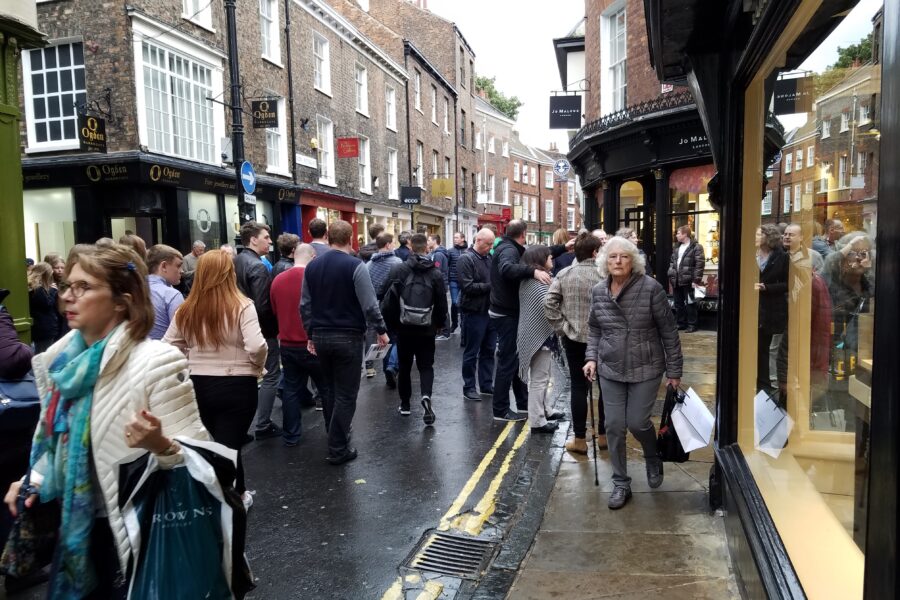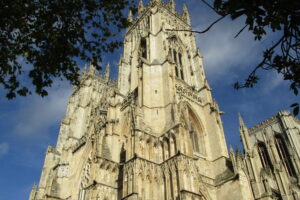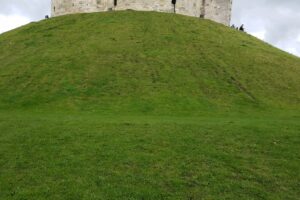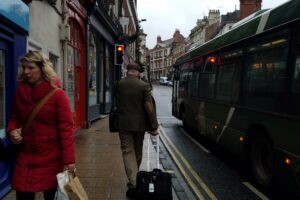Now, standing here reading a quote from the life of St. Oswald who lived between the years AD 970 – 1020, which states, “…the city (York) is crammed beyond expression, and enriched with the treasures of merchants, who come from all parts…”
I suddenly realize that…
…York is York is York, apparently always being its essential self. From 71 A.D it has been pillaged and plundered, shattered and resurrected. It is like an onion, hitting you in the face with its heady history—layer upon layer of stories, life and death, war and peace, and always always merchants and invaders—today they are called tourists. To reach its core may be all but impossible. Of course we start our exploration almost halfway into its existence. Why begin at the beginning when our knife gets stuck in the middle?


The Viking Center takes us by the hand, sits us in an air born carriage that feels private—just me and Michael walking back in time—whisking us through history, recreating daily life in Jorvik. We are the proverbial fly on the wall, time warped to more than 1,000 years earlier. Watching. Listening.

Even though the myriad vignettes of daily life intrigue, the most fascinating things I see are in the museum—the artifacts from the digs the archaeologists unearthed beginning in 1972. A hair comb almost perfectly intact; a woman’s shoe, so close to a style still worn today; a frying pan. Our essential needs have always been the same—the solutions likewise. Nothing is new—only technology and our ability to mass produce.



Deep in reflected thoughts, we return to the apartment where we opt for an early happy hour with our miniature pork pies in lieu of a late lunch. Still later we take a leisurely stroll around the Shambles. With no true destination, we wander, exploring nooks and crannies away from the multitudes. Reaching a seeming dead end, Michael continues on–he never did like to back track—winding his way through back alleys, refuse containers, squeezing his way through narrow openings. It is the Caldwell way. I would never lead, but I’m happy to follow.





York is crowded, noisy, messy and wet and cold. Too busy with too many people too many cars and too many buses. It overwhelms. But it is not its fault. Having a population of a little more than 200,000 in 2012, York has more than 7,000,000 visitors each year—more than 35 times its population. Blame it on the Romans the Anglo Saxons the Vikings the Normans and the kings and queens of Great Britain who all left their mark.
About the Jorvik Viking Center
When I first read and heard about the newly reimagined recently reopened Viking Center (closed, rebuilt and reimagined due to flooding) that contained carriages that took you through a time buried Jorvik populated by animatronic Vikings, my first thought was Disneyland. To say I was ambivalent about the proposed experience could be considered an understatement. But this is different. Traveling through darkness in most instances I feel that Michael and I are the only individuals in the village, as we hear the story of daily life filtered through individual speakers at ear level built into our carriage seats.
Viking History of York
Before 850 Viking attacks had been short and brutal, but in that year for the first time they stayed in Britain through the winter. By 866 they were well established and had gathered a great army.
On November 1, 866, led by Halfdan and Ivar the Boneless (portrayed as the youngest son of Ragnar Lothbrok in the History Channel series The Vikings), the Viking army marched north and took the royal city at the heart of the kingdom of Northumbria – York.
The Viking army spent the winter on the Tyne and had to recapture York in March 867.
In 870 the kingdom of East Anglia fell to the Vikings and Mercia followed in 874. In the following years the Vikings secured the land around York, settling and farming it.
After a series of campaigns against other kingdoms, part of the great Viking army returned to Northumbria in 876.
Norwegian Vikings invaded from Ireland and captured York. Their leader, Ragnald, made himself king. This Norse Kingdom lasted without interruption for 35 years.
For the best part of a century large parts of the north and east of England were ruled by Viking kings based in York. The last of these was Eric Bloodaxe who was defeated in 954. From then on, York and Northumbria were always part of a united Anglo-Saxon kingdom.









Leave a Reply
Your email is safe with us.